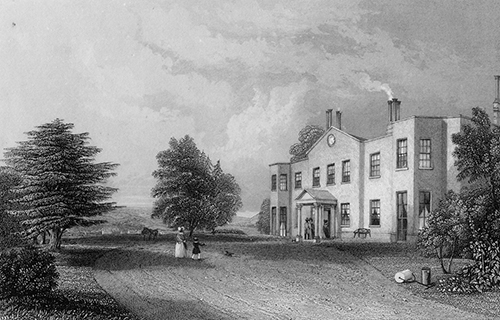Denbies [I]
Surrey
| Location | Ranmore | ||
| Year demolished | c.1850-51 | ||
| Reason | Replaced by a new house | ||
| See all images: | Gallery | ||
| << Back to the main list |
Although once a farm house, Denbies became the symbol of the success of one Jonathan Tyers, owner of the famous Vauxhall Pleasure Gardens in London. The gardens, originally called New Spring Gardens, opened in 1661 but had subsequently declined until Tyers took on the tenancy of the Gardens in 1728 and, with William Hogarth (the painter), revived their fortunes after a grand re-opening in 1732.
 Pleasure gardens originated in England and were usually to be found on the edges of existing urban areas, within easy reach of local transport, providing music, illuminations, walks, pavilions and much-admired plantings. Open in the evenings, they afforded the opportunity for those with the admission fee and who were respectably dressed, the chance to mix with polite society, as the gardens were hugely popular with all classes. Their popularity quickly made Jonathan Tyers wealthy and in 1734 he bought a farm house in Surrey and rebuilt it as a gentleman's residence.
Pleasure gardens originated in England and were usually to be found on the edges of existing urban areas, within easy reach of local transport, providing music, illuminations, walks, pavilions and much-admired plantings. Open in the evenings, they afforded the opportunity for those with the admission fee and who were respectably dressed, the chance to mix with polite society, as the gardens were hugely popular with all classes. Their popularity quickly made Jonathan Tyers wealthy and in 1734 he bought a farm house in Surrey and rebuilt it as a gentleman's residence.
The estate, Denbies, named after the first owner John Denby, was centred on a modest, two-storey Georgian house sited at the top of a small ridge, looking out over the South Downs. G.F. Prosser, writing in the 1820s, said that it '...commands one of the most beautiful and extensive prospects in the county of Surrey'. Tyers rebuilt the house on a relatively modest scale with a five-bay central block with the central three projecting forwards, surmounted by a pediment, and with two flanking wings. Internally, Prosser also wrote that '...the apartments, though not spacious, are convenient'1.
Despite the house being little out of the ordinary, the same could not be said of the gardens. It has been suggested ('Vauxhall Gardens: A History' by Coke & Borg [2012]) that Tyers may have been suffering from mental illness, but the gardens may have been a response to the excess of pleasure and frivolity he saw outside the window of his house in the Vauxhall Gardens.
To the surprise of those who toured the Denbies garden, rather than the delights of Vauxhall, Tyers took a darker, more macabre, inspiration. Named 'The Valley of the Shadow of Death', he decorated them with momento mori (or 'reminders of death'). The focus of the garden was an eight-acre, densely-planted wood called 'Il Penseroso' (The Serious Man), possibly after the poem of the same name by John Milton. Before entering the dark and complex pathways through the woodland, which must have created an oppressive atmosphere, visitors would see a hermitage called 'The Temple of Death' which contained a clock with chimed each minute, walls decorated with 'many inscriptions of a serious character' (Prosser), a book with verses about death, and a statue by Louis-François Roubiliac showing an angel blowing a trumpet to signal the end of the world, with a pyramid disintergrating to allow the dead to rise.
The heavy entrance gates to the wood were mounted on two upright coffins, each topped with a skull, one male, under which it stated that 'Men, at their best state, are altogether vanity', and the other female, chiding that 'beauty is vain'. An amphitheatre contained a statue representing Truth trampling the mask of illusion underfoot and two images of the Christian and the Unbeliever showing the contrast at the last moments of their lives.
Tyers often only visited Denbies on Sundays but he enjoyed his eccentric surroundings for another 13 years before he died in 1767. The sombre character of the gardens and the lack of public access meant that it's not thought that any illustrations or drawings were made of Tyers creation. The house was sold initially to Thomas King, 5th Baron King (1712–1779), who cleared the garden of the gloomy artefacts and remodelled the garden, thus erasing one of the eighteenth-century's most interesting experiments in garden design.
Following a succession of owners, in 1787 it was bought by a wealthy banker named Joseph Denison. After his father's death in 1806, his son, William Joseph, expanded the estate and made extensive changes. Like his father, his career in banking had made him immensely wealthy and at his death, in August 1849, he was considered on the ten richest businessmen of the time, as well has having served as an MP since 1818. As a bachelor, he had no children so he left his entire fortune of £2.3m (approximately £244m) to his nephew Albert (as long as he changed his surname from Conyngham to Denison) who then sold the house and now 3,900-acre estate to Thomas Cubitt in 1850. Cubitt built a new house on the same site - also called Denbies - and then demolished the first house soon after he moved into the new house in 1854.
1 - 'Select Illustrations of the County of Surrey' G.F. Prosser (1828)
Further information about the history: Wikipedia: Denbies